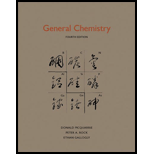
Interpretation:
The new partial pressure of
Concept Introduction:
Equilibrium constant
In gas phase reactions, partial pressure is used to write equilibrium equation than molar concentration. Equilibrium constant
Consider the reaction where A reacts to give B.
On rearranging,
Where,
Explanation of Solution
Given:
The partial pressures of
The equilibrium chemical equation of the reaction is,
Calculation of new partial pressures:
The equilibrium constant expression of the given reaction is,
Calculate the equilibrium constant.
Determine the change in pressure and the new partial pressure for
Initial total pressure of the reaction is
Final total pressure after addition of
The change in pressure is,
The new partial pressure of
Construct ICE table for the reaction.
| Initial | 13.2 | 32.8 | 217 |
| Change | -x | -x | +x |
| Equilibrium | 13.2 - x | 32.8 - x | 217+x |
Plug the equilibrium pressures from ICE table in equilibrium constant expression and solve for x.
Substitute ‘x’ in the equilibrium partial pressure of ICE table and solve for new partial pressures.
Therefore, the new equilibrium partial pressures of
Want to see more full solutions like this?
Chapter 19 Solutions
General Chemistry
 ChemistryChemistryISBN:9781305957404Author:Steven S. Zumdahl, Susan A. Zumdahl, Donald J. DeCostePublisher:Cengage Learning
ChemistryChemistryISBN:9781305957404Author:Steven S. Zumdahl, Susan A. Zumdahl, Donald J. DeCostePublisher:Cengage Learning ChemistryChemistryISBN:9781259911156Author:Raymond Chang Dr., Jason Overby ProfessorPublisher:McGraw-Hill Education
ChemistryChemistryISBN:9781259911156Author:Raymond Chang Dr., Jason Overby ProfessorPublisher:McGraw-Hill Education Principles of Instrumental AnalysisChemistryISBN:9781305577213Author:Douglas A. Skoog, F. James Holler, Stanley R. CrouchPublisher:Cengage Learning
Principles of Instrumental AnalysisChemistryISBN:9781305577213Author:Douglas A. Skoog, F. James Holler, Stanley R. CrouchPublisher:Cengage Learning Organic ChemistryChemistryISBN:9780078021558Author:Janice Gorzynski Smith Dr.Publisher:McGraw-Hill Education
Organic ChemistryChemistryISBN:9780078021558Author:Janice Gorzynski Smith Dr.Publisher:McGraw-Hill Education Chemistry: Principles and ReactionsChemistryISBN:9781305079373Author:William L. Masterton, Cecile N. HurleyPublisher:Cengage Learning
Chemistry: Principles and ReactionsChemistryISBN:9781305079373Author:William L. Masterton, Cecile N. HurleyPublisher:Cengage Learning Elementary Principles of Chemical Processes, Bind...ChemistryISBN:9781118431221Author:Richard M. Felder, Ronald W. Rousseau, Lisa G. BullardPublisher:WILEY
Elementary Principles of Chemical Processes, Bind...ChemistryISBN:9781118431221Author:Richard M. Felder, Ronald W. Rousseau, Lisa G. BullardPublisher:WILEY





